Hair rebonding is a chemical process that permanently transforms curly, wavy, or frizzy hair into sleek, straight locks. This comprehensive guide will help you understand the procedure, its benefits, potential risks, and essential aftercare to maintain healthy rebonded hair.
Whether you're considering hair rebonding for the first time or looking to maintain your treated hair, it's crucial to understand what the process entails and how to protect your hair's health throughout the treatment journey.
Understanding Hair Rebonding
Hair rebonding works by breaking down the natural bonds in your hair structure and reforming them to create straight strands. The process involves applying a relaxing cream to break the existing bonds, followed by a neutralizer to rebuild these bonds in a straight configuration.
The procedure typically takes 4-6 hours, depending on your hair length and thickness. Professional stylists perform this treatment in specialized salons using specific chemical formulations designed for different hair types.
The Hair Rebonding Process
Initial Consultation
Before beginning the treatment, your stylist should conduct a thorough assessment of your hair's condition, texture, and previous chemical treatments. This evaluation helps determine if your hair is suitable for rebonding and which products will work best for your specific hair type.
Treatment Steps
The rebonding process follows these essential stages:
- Deep cleansing and conditioning
- Application of relaxing cream
- Heat straightening with flat iron
- Neutralizer application
- Final styling and sealing
Benefits of Hair Rebonding
When performed correctly, hair rebonding can offer several advantages:
- Permanently straight, manageable hair
- Reduced styling time
- Elimination of frizz
- Long-lasting results
- Smoother, shinier appearance
Aftercare and Maintenance
Proper aftercare is crucial for maintaining healthy rebonded hair. Following the treatment, you should:
- Wait 72 hours before washing your hair
- Use sulfate-free shampoo and conditioner
- Avoid tight hairstyles for two weeks
- Apply heat protectant before styling
- Schedule regular trim appointments
Essential Products for Rebonded Hair
Maintaining rebonded hair requires specific products:
- Protein-rich shampoos
- Deep conditioning treatments
- Leave-in conditioners
- Heat protectant serums
- Anti-frizz products
Frequently Asked Questions
What are the benefits and risks of hair rebonding for people with curly or frizzy hair?
The main benefits include permanently straight hair, reduced styling time, and improved manageability. However, risks include potential chemical damage, hair breakage, and scalp irritation if not performed correctly or maintained properly.
How often should I get hair rebonding touch-ups to maintain straight hair?
Touch-ups are typically needed every 6-8 months, focusing only on new growth. Waiting this length of time helps minimize damage to previously treated hair while maintaining the desired straight appearance.
Can hair rebonding cause permanent damage or breakage if done improperly?
Yes, improper rebonding can cause severe damage, including breakage, extreme dryness, and even hair loss. Always choose a certified professional and follow proper aftercare instructions to minimize these risks.
Is hair rebonding safe for pregnant women due to the chemicals involved?
Hair rebonding is not recommended during pregnancy due to the strong chemicals used in the process and the potential for scalp absorption. It's best to wait until after pregnancy and breastfeeding to undergo this treatment.
What are some recommended hair care products for maintaining healthy rebonded hair?
Essential products include sulfate-free shampoos, protein-enriched conditioners, weekly deep conditioning masks, leave-in treatments, and heat protectant products. Look for products specifically formulated for chemically treated hair.




